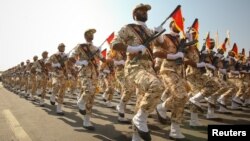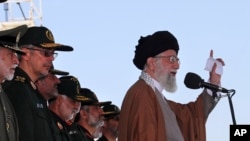U.S. President Donald Trump directed the U.S. Treasury Department to impose additional sanctions on Iran’s Revolutionary Guard as he announced a more aggressive stance toward Iran, including refusing to recertify the nuclear deal with Tehran.
The White House called the Revolutionary Guard, which is separate from Iran’s regular armed forces, a “primary tool and weapon in remaking Iran into a rogue state.” But what is the Revolutionary Guard?
Beginnings
The Revolutionary Guard was founded following Iran’s 1979 Islamic revolution, in which the shah, Mohammad Reza Pahlavi, was overthrown by a cleric-led uprising. The Revolutionary Guard was created to enforce the new Islamic government and operated parallel to the country’s regular armed forces. Once a ragtag force protecting the new regime, it is now the nation’s most powerful security institution.
Expanded force
The Revolutionary Guard has between 120,000 and 150,000 active personnel operating air, land and sea defense capabilities. Its elite Quds Force, which the Treasury Department designated a terrorist organization in 2007, is responsible for external operations. Domestically, the guard controls a large network of paramilitary volunteers, known as the Basij.
Loyal to supreme leader
The Guard only answers to Iran’s supreme leader. After the 1979 revolution, the guard faced possible disbanding, but Supreme Leader Ayatollah Ali Khamenei allowed it to thrive and granted it more powers. Since then, the guard has been loyal to the supreme leader and the group’s powers have since been enshrined in the country’s constitution.
Political and economic actor
While the Revolutionary Guard has expanded militarily, it has also become a force within the political scene. Current and former members of the guard hold important posts in government, including foreign and security policy. The guard also has holdings in media, manufacturing, construction, banking and other sectors of the Iranian economy.
Sponsor of terrorism
In announcing the new sanctions Friday, the U.S. Treasury Department said it was designating the Revolutionary Guard as a terrorist entity under a White House Executive Order. It said the group provides “support to a number of terrorist groups, including Hezbollah and Hamas, as well as to the Taliban.”
Ballistic missiles
The Revolutionary Guard oversees Iran’s ballistic missile program and has fired several missile tests since the nuclear deal in 2015. While the nuclear deal does not forbid missile tests, U.S. officials say they violate the spirit of the agreement. The missiles that have been tested can reach Israel, and in March 2016 the Revolutionary Guard launched a test missile bearing the words “Israel must be wiped out.”












